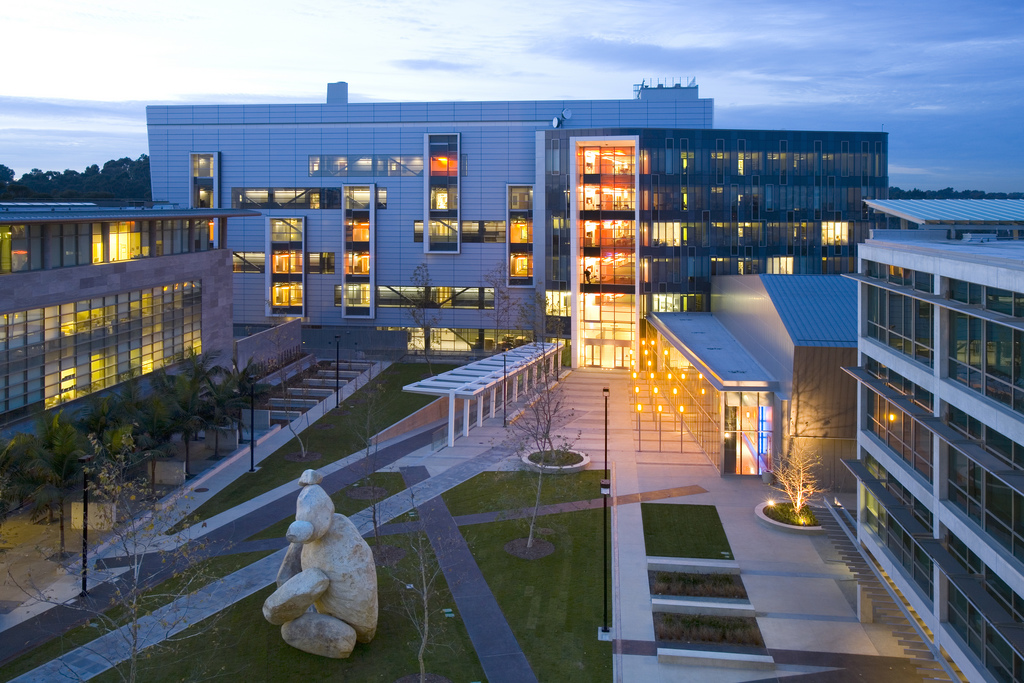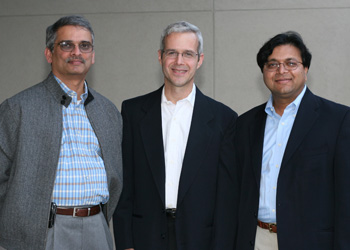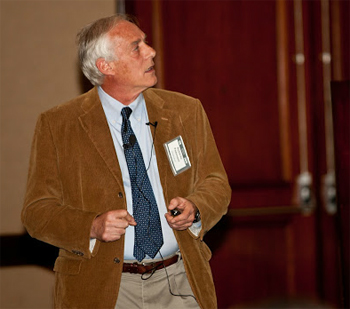Multidisciplinary Research Institute at UC San Diego Named in Honor of Qualcomm
San Diego, April 2, 2013 -- The University of California, San Diego is renaming its division of the California Institute for Telecommunications and Information Technology (Calit2) in honor of the philanthropy of the San Diego-based wireless technology leader, Qualcomm Incorporated. The multidisciplinary research center will now be known as the Qualcomm Institute for Telecommunications and Information Technology, the UC San Diego Division of Calit2, or Qualcomm Institute for short.
|
“This recognition is much deserved given the important roles that Qualcomm and the Qualcomm Foundation have played in helping us to build and cement the institute’s reputation as a world leader in technologies that benefit society,” said UC San Diego Chancellor Pradeep K. Khosla. “The new name is a fitting tribute to Qualcomm as Calit2’s largest industry supporter and one of the main employers of our alumni. It also honors the many ways in which the company and its engineers have collaborated with UC San Diego faculty, staff and students.”
Calit2 will remain the name of the combined institute, which includes the divisions at UC San Diego and UC Irvine. Calit2 is one of four Governor Gray Davis Institutes for Science and Innovation, so named in 2008 to recognize the former governor's role in their creation. The state and the University of California established the institutes in December 2000 as an investment in the state's economic future to maintain California's reputation for fostering innovation, scientific discoveries and new industries.
|
“We are heading into the 13th year of our Calit2 Summer Undergraduate Research Scholars program, which gives up to 30 undergrads each summer the opportunity to do full-time research in a UCSD lab,” said Rao, a professor in the Electrical and Computer Engineering (ECE) department. “Without the discretionary support provided by Qualcomm and the Qualcomm Foundation, many of those students may have graduated with no hands-on research experience.” This year’s class of Calit2 Scholars will push the total number of program alumni to more than 300 undergraduates since 2001.
Qualcomm also funded 160 Calit2 Graduate Fellowships over five academic years starting in 2001-02, with most of them full $30,000 awards. The first- or second-year fellowships were allocated to 15 different academic departments to increase the quality and quantity of accepted students and integrate them into research teams under faculty advisors.
Funds from the company also were used to establish five endowed chairs in critical areas: embedded microsystems, mobile computing, telecommunications and IT, information theory and its applications, as well as communications and technology policy. Four of the five chairs are in the Jacobs School of Engineering, the fifth in the Graduate School of International Relations and Pacific Studies.
|
“The endowed chairs have been critical to the recruitment and retention of stellar faculty in the Jacobs School,” said Frieder Seible, Dean Emeritus of the Jacobs School. “For example, we were able to attract in 2009 computer science and engineering professor Yuanyuan Zhou from a tenured faculty position at the University of Illinois at Urbana-Champaign. She went on to establish a large research group and brought in millions of dollars in federal research funds to UC San Diego – none of which may have happened without Qualcomm, Calit2 and that endowed chair.”
Looking to the future, the Qualcomm Institute aims to foster more collaboration between the institute and researchers in industry. On May 24, the institute will mark the transition and name change with an open house at its Atkinson Hall headquarters for the public at large, the campus community and industry partners, including Qualcomm employees.
“Every time someone from Qualcomm comes to the institute or our researchers go to Qualcomm, the visit results in an intellectual stimulation that benefits all of us,” Rao said. “Having the Qualcomm name on the UCSD division of Calit2 recognizes the long, persistent engagement at the institutional level, but we intend to work hard so that the engagement is happening at the individual researcher level, as well.”
That vision for the Qualcomm Institute is consistent with the original aspirations of Dr. Irwin Jacobs, who said in 2001 that the “combined expertise of academia and the private sector provides an opportunity for Calit2 to influence how we communicate in the era of convergence of the Internet and wireless communications.”
According to Jacobs School Interim Dean Juan C. Lasheras, “The Qualcomm Institute priorities are directly in line with the strategic research focus of the Jacobs School. For example, innovations being developed at the Qualcomm Institute in wireless health complement research underway on medical devices. We look forward to working with the Qualcomm Foundation, Qualcomm the company and other Institute industry partners on important societal challenges such as technologies that improve health care while reducing costs.”
Since its founding, more than 120 companies have partnered with Calit2 at UC San Diego in research or used the institute’s specialized facilities, such as the Nano3 nanofabrication cleanroom facility and industry-scale Photonic Systems Laboratory.
The UCSD division of Calit2 will gradually phase in the new name, logo and website for the Qualcomm Institute between now and the beginning of the 2013-’14 academic year.
|
In addition to undergraduate research scholarships, graduate fellowships and endowed chairs, Qualcomm and the Qualcomm Foundation have enabled Calit2’s research centers such as the Information Theory and Applications Center (ITA) to hire postdoctoral researchers and a cadre of technical research professionals who work with faculty and students to deploy innovations in “living laboratories” across the UCSD campus. In the case of ITA, it has also spawned an annual workshop that draws 600 experts in information theory – the theoretical underpinning of wireless and other sectors – from around the world.
Access to Qualcomm technology allowed Calit2-affiliated researchers to work with wireless systems long before they were commercialized. In 2001, Qualcomm installed its High Data Rate (HDR) wireless technology to support next-generation and high-speed, IP-based data services. The HDR base station was deployed on the roof of what is today Jacobs Hall, and it had a radius of approx. 10 kilometers, with “burst” rates of up to 2.4 megabits per second. The technology and footprint, together with two base stations on nearby Qualcomm buildings, allowed Calit2 to develop one of the first 3G consumer services in the world: students could use their laptops and Wi-Fi to interact with an HDR unit on campus shuttle buses, and browse the Internet while traveling from UC San Diego to a nearby train station.
Calit2 later worked with emergency-room physicians from UCSD’s Thornton Hospital to outfit a shuttle bus with ambulance equipment, to test the value of the Wi-Fi-plus-3G technology in emergency-response scenarios.
Qualcomm also provided its HDR technology (renamed CDMA2000 1x EV-DO) for Calit2’s StrokeDoc project, which made it possible for specialists at the UCSD Stroke Center to do remote examinations of possible stroke victims at rural emergency rooms. With funding from the National Institutes of Health, engineers from Calit2, Path 1 Network Technologies and Qualcomm demonstrated the StrokeDoc telemedicine application in 2004, and later clinical trials confirmed that the technology could save lives by making it possible to diagnose a stroke and administer a clot-busting drug within the maximum three hours allowed from the onset of a patient’s symptoms.
More recently, Qualcomm and Qualcomm Foundation support allowed the institute to launch the Calit2 Strategic Research Opportunities (CSRO) peer-reviewed grant program. The first round was timed to coincide with the institute’s 10-year anniversary in 2010, and the second round took place in 2012, when Calit2 awarded $826,000 in cash, in-kind support and graduate fellowships to 17 one-year projects led by UCSD faculty – up 18 percent from the level in 2010.
Media Contacts
Doug Ramsey, 858-822-5825, dramsey@ucsd.edu
Related Links
Calit2
Qualcomm Foundation
Qualcomm, Inc.





